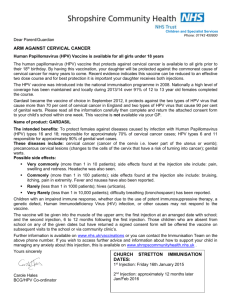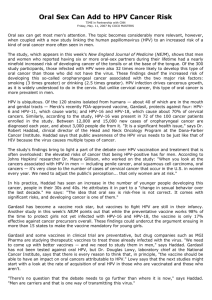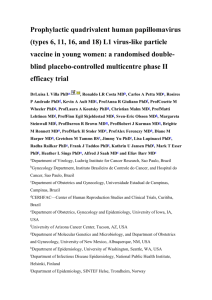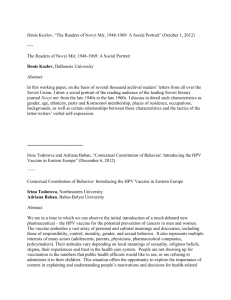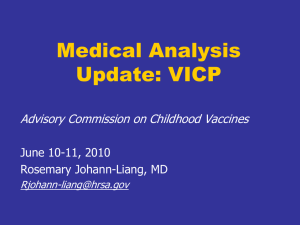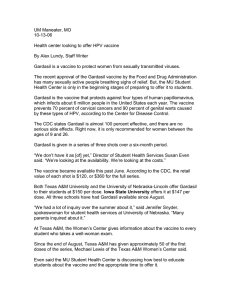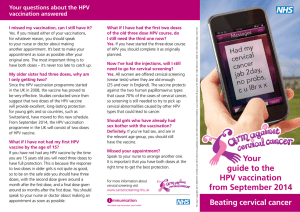Human Papillomavirus
advertisement
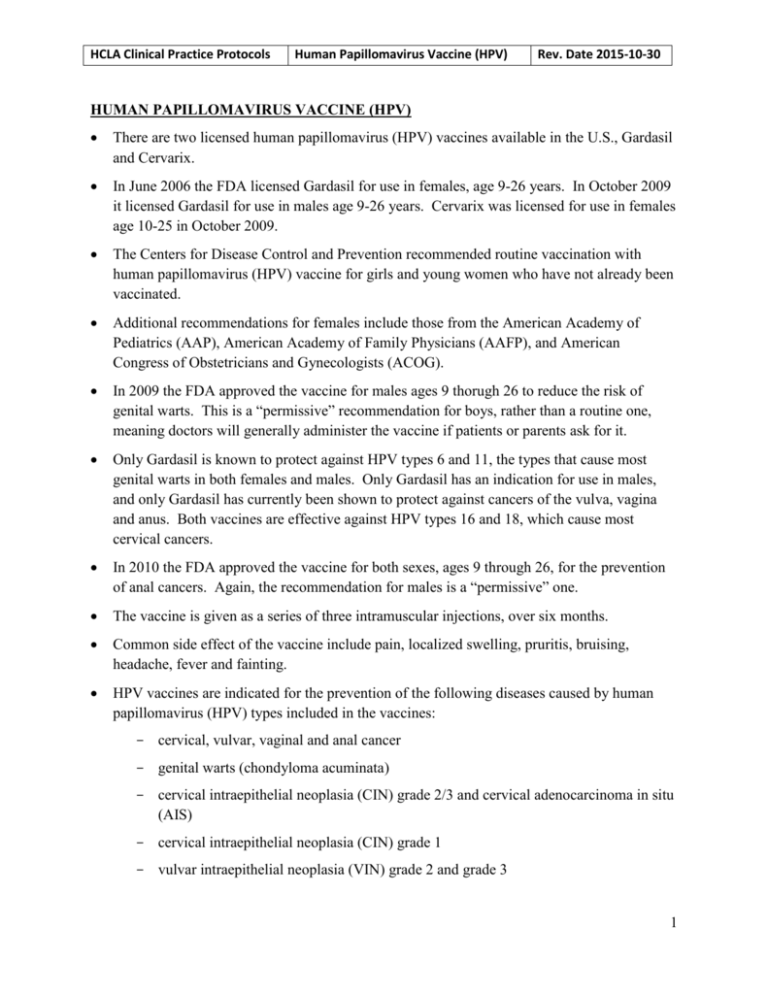
HCLA Clinical Practice Protocols Human Papillomavirus Vaccine (HPV) Rev. Date 2015-10-30 HUMAN PAPILLOMAVIRUS VACCINE (HPV) There are two licensed human papillomavirus (HPV) vaccines available in the U.S., Gardasil and Cervarix. In June 2006 the FDA licensed Gardasil for use in females, age 9-26 years. In October 2009 it licensed Gardasil for use in males age 9-26 years. Cervarix was licensed for use in females age 10-25 in October 2009. The Centers for Disease Control and Prevention recommended routine vaccination with human papillomavirus (HPV) vaccine for girls and young women who have not already been vaccinated. Additional recommendations for females include those from the American Academy of Pediatrics (AAP), American Academy of Family Physicians (AAFP), and American Congress of Obstetricians and Gynecologists (ACOG). In 2009 the FDA approved the vaccine for males ages 9 thorugh 26 to reduce the risk of genital warts. This is a “permissive” recommendation for boys, rather than a routine one, meaning doctors will generally administer the vaccine if patients or parents ask for it. Only Gardasil is known to protect against HPV types 6 and 11, the types that cause most genital warts in both females and males. Only Gardasil has an indication for use in males, and only Gardasil has currently been shown to protect against cancers of the vulva, vagina and anus. Both vaccines are effective against HPV types 16 and 18, which cause most cervical cancers. In 2010 the FDA approved the vaccine for both sexes, ages 9 through 26, for the prevention of anal cancers. Again, the recommendation for males is a “permissive” one. The vaccine is given as a series of three intramuscular injections, over six months. Common side effect of the vaccine include pain, localized swelling, pruritis, bruising, headache, fever and fainting. HPV vaccines are indicated for the prevention of the following diseases caused by human papillomavirus (HPV) types included in the vaccines: - cervical, vulvar, vaginal and anal cancer - genital warts (chondyloma acuminata) - cervical intraepithelial neoplasia (CIN) grade 2/3 and cervical adenocarcinoma in situ (AIS) - cervical intraepithelial neoplasia (CIN) grade 1 - vulvar intraepithelial neoplasia (VIN) grade 2 and grade 3 1 HCLA Clinical Practice Protocols Human Papillomavirus Vaccine (HPV) Rev. Date 2015-10-30 - vaginal intraepithelial neoplasia (VaIN) grade 2 and grade 3 - anal intraepithelial neoplasia (AIN) grades 1, 2 and 3 Vaccination does not substitute for routine cervical screening. Women who receive HPV vaccine should continue to undergo cervical cancer screening per standard of care. Vaccination does not protect against disease from HPV types to which the recipient has already been exposed. Since syncope has been reported following vaccination, sometimes resulting in falling with injury, observation for 15 minutes after administration is recommended. Safety has not been established in pregnant women. HPV vaccine is not recommended for use in pregnant women or those planning to become pregnant during the vaccination course. References: Gardasil package insert, Merck & Co, Inc., Whitehouse Station, NJ 08889, USA Cervarix package insert, GlaxoSmithKline Biologicals, Research Triangle Park, NC 27709 “Vaccine safety, Reports of Health Concerns Following HPV Vaccination”, Centers for Disease Control and Prevention, Atlanta, GA, 8/8/11. American Academy of Pediatrics, “2011 Schedule of Recommended Vaccines for Immunizations for Children and Teens.” Vaccine Status Table from Red Book Online. “Prevention of Human Papillomavirus Infections: Provision of Recommendations for Immunization of Girls and Women with Quadravalent Human Papillomavirus Vaccine”, American Academy of Pediatrics Policy Statement, 9/1/10. 2


